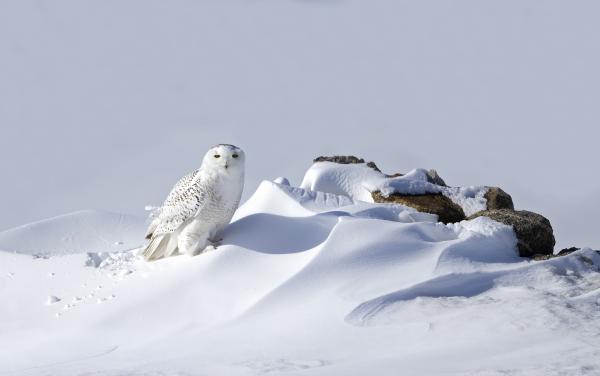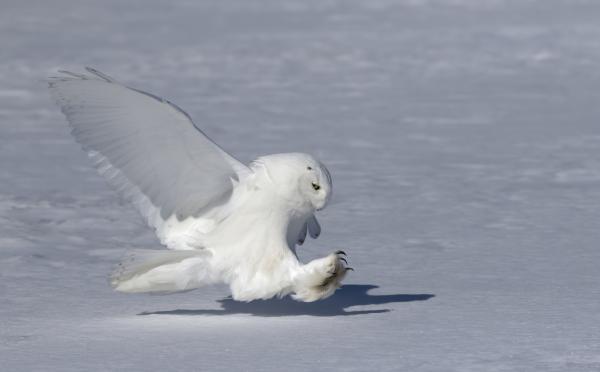The Snowy Owl (Bubo scandiacus) is a striking nocturnal raptor easily recognized by its dazzling white plumage. Famous as one of the largest and most unique owls on the planet, the Snowy Owl inhabits some of the coldest regions on Earth. In this article, you’ll discover everything you need to know about the Snowy Owl: its physical characteristics, natural habitat, migration patterns, main food sources, and reproduction—all designed to help you understand this Arctic icon and boost your wildlife knowledge.

White Plumage & Sexual Dimorphism: Snowy Owls are covered in pure white feathers. Males are generally whiter, while females display more dark spots or bars, making it easy to tell them apart.
Cold Weather Adaptations: Their thick, long feathers act as insulation against extreme Arctic cold. Even their beaks and toes are fully feathered to minimize heat loss, essentially providing them with a built-in "down jacket."
Powerful Predators: Snowy Owls have robust, thick toes and sharp talons—perfect for seizing and dispatching prey.
Superb Vision: Their large, forward-facing yellow eyes give them excellent depth perception and hunting accuracy, even in low light.
Impressive Size: One of the world’s largest owls, females can measure 54-71 cm in length, with a wingspan up to 159 cm and a weight ranging from 1.4 to 2.4 kg. Males are slightly smaller.
Long Lifespan: Snowy Owls typically live up to 10 years in the wild and as long as 23 years in captivity.
Unusual Habits: Unlike most owls, the Snowy Owl is primarily diurnal, hunting and being most active during the day.
Arctic Specialist: Snowy Owls are found throughout the Arctic Circle, including regions of Europe, Asia, and North America. They thrive in tundra, grasslands, and even sand dune habitats.
Perfect Camouflage: Their white plumage blends seamlessly with the snowy landscape, providing both camouflage from predators and an advantage when hunting prey.
Adapted for Migration: Snowy Owls migrate seasonally based on food availability. In winter, they may move southward in search of prey; during the breeding season in summer, they return to the Arctic tundra.

Long-Distance Travelers: Although built for the cold, some Snowy Owls migrate thousands of kilometers to more temperate areas when food is scarce or conditions are too extreme.
Responsive to Food Supply: Their migration patterns are closely linked to the abundance of prey, particularly lemmings, and to their breeding cycles. When food is plentiful in the north, Snowy Owls may remain year-round.
Primary Prey: The favorite food of the Snowy Owl is the lemming—a small Arctic rodent. A single Snowy Owl can consume up to 1,600 lemmings in a year!
Flexible Diet: When lemmings are scarce, Snowy Owls prey on other small mammals such as rabbits, squirrels, moles, and voles, as well as birds like ptarmigans, ducks, and gulls. Occasionally, they will also eat fish or carrion if needed.
Hunting Techniques: Snowy Owls often wait patiently for prey to come close, or they glide low over the ground to surprise their target. Smaller animals are swallowed whole, and indigestible parts such as bones and feathers are later regurgitated as pellets.

Linked to Food Abundance: The reproductive success of Snowy Owls is closely tied to the availability of food. In years when prey is abundant, they lay more eggs and raise more chicks.
Courtship & Nesting: During the breeding season, males perform aerial displays to attract females. After mating, the female lays 5-13 eggs in a shallow ground nest, laying one egg per day.
Raising the Young: The eggs hatch after about one month, and both parents care for the chicks. The young owls leave the nest about a month after hatching.
The Snowy Owl became world-famous as “Hedwig,” Harry Potter’s loyal companion in the film series. Interestingly, Hedwig was portrayed by a male Snowy Owl, although the character was female in the books.
Bibliography
Lleó, A. (2015) The Sun and the Earth in Evolution: The Brotherhood of All Living Beings on Planet Earth. Madrid: Polytechnic University of Madrid.
Julivert, M. (2013) Birds of Prey. Barcelona: Parramón Paidotribo.
animal tags: Snowy Owl
We created this article in conjunction with AI technology, then made sure it was fact-checked and edited by a Animals Top editor.